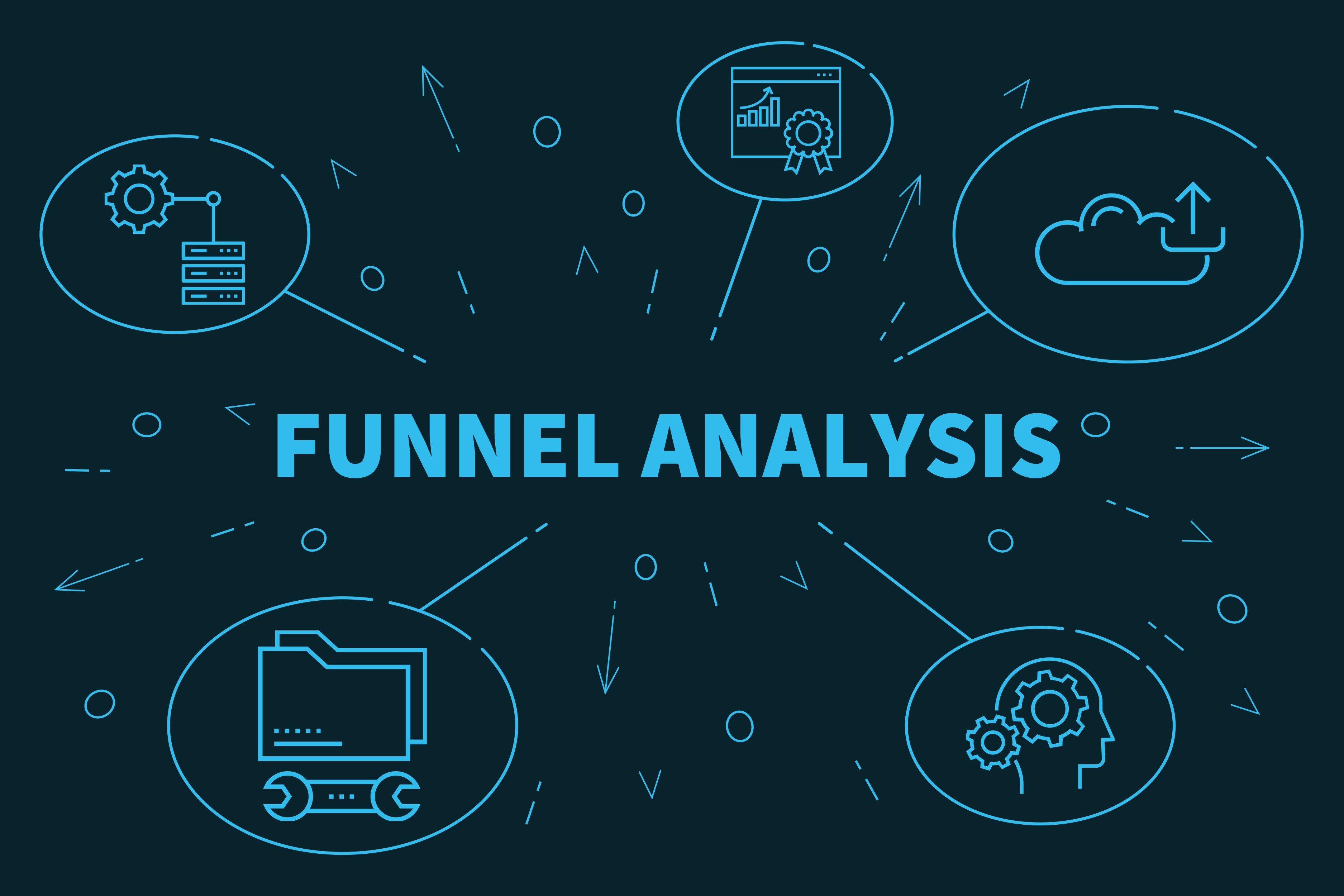
Yusuf Shurbaji
July 3, 2023
|
7.5
min read
The odds are good that your business already collects user data and transforms it into user funnels. User funnels are valuable tools that you can use to see how customers progress through their experiences with your brand.
But to make the most of your funnels, you need to know how to do a funnel analysis. Let’s talk about how to perform this analysis technique and leverage it to boost brand conversions.


Funnel analysis is a data analytics technique that lets you analyze a sales or marketing funnel to learn key information. Specifically, you analyze a distinct sequence of events that leads up to any point of conversion, like making a purchase or subscribing to a service.
A "funnel" – whether that's a sales funnel, marketing funnel, or some other funnel – is a graphical representation of a website visitor’s journey through your site or online business. The funnel is always inverted, with the wider sections representing more common steps (like visiting your website or entering your store).
The lower, narrower parts of the funnel represent less common steps in a journey (like making a purchase or subscribing to a newsletter).
Seeing users’ journeys represented through the funnel metaphor is always valuable, but you will get much more actionable information through proper funnel analysis.
With data-driven conversion funnel analytics, you can:
Though you can perform funnel analysis on both sales and marketing funnels, it helps to understand the differences between these funnel types as well.
A marketing funnel describes a customer's relationship with your brand and all the kinds of content it makes.
That content can include:
Because of this, most marketing funnels are comprised of five segments:
A sales funnel is similar but shows a customer’s relationship with your sales team. It includes all the moments from when a sales representative contacts a lead to the point when they become a loyal client or customer.
Sales funnels can broadly be described in three distinct segments:
Performing a funnel analysis is, fortunately, very straightforward. However, it isn’t easy.
First, you need to construct funnel models for your marketing or sales teams. Once you do that, you’ll need to define your metrics.
Defining metrics is important so you know what kind of data you will try to track and what analyses you will plan to perform.
Most ecommerce websites track KPIs or key performance indicators like:
Once you identify the metrics you’ll analyze with your funnel analysis, you can move on to the next stage: identifying key touchpoints.
Key touchpoints are all the crucial moments a customer experiences concerning your brand. Touchpoints can include, for example, visiting your site for the first time, speaking to a sales rep, etc.
Understanding the right touchpoints to identify means understanding the goals that your users have in mind. For instance, if you run an average ecommerce site, the user could browse your site's "new products" page. Then they might make a search query to look for a specific product.
By looking at this customer journey through each step of your funnel, you can identify different touchpoints, such as entering a search query, finding a specific product page, and much more. In summary, to identify all the correct touchpoints, make sure that you identify and mark down all the possible paths that a prospective customer could take to conversion.
Lastly, you should perform an in-depth analysis by segmenting your different users. You can segment your users by demographic factors and attributes, like:
Once you have segmented your different users, you can analyze those groups’ funnels and activities. In turn, this will give you greater insights into your customers' needs, wants, and pain points.
You can use a funnel analysis to boost conversions simply by getting a greater insight into your target audience members. If you do it right, funnel analysis acts as a window into the minds of your consumers, showing you where they made their final decisions to click away from your site or make a purchase.
In the long term, you can use funnel analyses to boost conversions by designing your site for greater user experiences or UX. In this way, your site will become a much better place to shop and much more responsive or intuitive for your target customers.

There are several important benefits to doing a conversion funnel analysis for target customer groups. Here’s a breakdown of some of those advantages.
Firstly, a funnel analysis can help you improve conversions. When you better understand your target customers, you’ll understand:
Funnel analyses can help you enhance the UX across the board. As an example, if your customers almost make it to the end of the sales funnel but frequently have issues with checkout, it could be a sign that you need to revamp and streamline your checkout page.
Funnel analysis can further help you identify big drop-off areas on your website. For example, if you notice that customers leave the sales funnel at a particular point – like a specific product page – you know that the problem is on that page instead of your checkout page or landing page.
Furthermore, funnel analysis can help you identify what brings in the highest quality, highest value visitors. This can help you focus your marketing efforts more specifically and effectively or help your sales team target the best leads possible.
Of course, a core component of funnel analysis is segmenting your users into different cohorts and groups. Using this strategy, you’ll be able to target distinct groups of customers among your broader target audience, enabling more effective marketing and greater conversions over time.
With funnel analysis, you'll get actionable, concrete, and accurate data you can leverage to improve your brand's performance in more ways than one. That's time saved that you might normally use to scratch your head, wondering where to make improvements on your ecommerce store for maximum effect.
Let’s break down a hypothetical example of a funnel analysis so you can see this concept in action.
Say that you want to improve your site's conversion rate and maximize the monthly purchasers you get for your core product lineup. To do that, you do a funnel analysis for all potential customers who arrive at your site via PPC Google and social media ads.
You already know that those customers’ first touchpoints are marketing ads, so you start constructing your funnel with that as the top level.
Then you identify other potential touchpoints your customers may experience, such as:
Once you’ve constructed your funnel, you identify KPIs like purchases, time spent on the page, and more. Then you separate all the web traffic you get from your Google PPC or social media ads into different groups.
For one group, your funnel analysis shows that people from social media are more likely to click on a specific product showcased in the social media ad. For another group, you determine that the search bar is clunky or slow, causing people to bounce from the landing page without delving deeper into your site.
These pieces of information are invaluable as you continually optimize your brand for conversion rate improvements.
As you can see, funnel analysis is a cornerstone type of data analysis your brand should frequently do. But you don't necessarily have to tackle funnel analysis by yourself.
Instead, you can partner with knowledgeable experts like Prismfly. Our conversion rate optimization specialists can help you build, measure, and analyze funnels as users visit your website and make purchases. With our assistance, you’ll perform in-depth, effective funnel analyses that give you the information you need to improve your ecommerce store. Contact us today.

Yusuf Shurbaji
Co-Founder & Managing Partner
Yusuf Shurbaji has over a decade of ecommerce growth experience. His past work includes building optimization departments & running experimentation inhouse and agency side for Dior, JCPenney, LVMH, American Precious Metals Exchange, Princess Polly, Built Brands, Ladder Sport, Maze Group, HelloFresh, Ledger, Blockchain.com, Kind Snacks, and other 9-figure brands. Yusuf is a Co-Founder of Prismfly, a conversion rate optimization agency focused on growing revenue and EBITDA for D2C ecommerce brands. Prismfly is the first CRO focused Shopify Plus certified agency and has seen triple digit growth the past 2 years.
Yusuf Shurbaji





